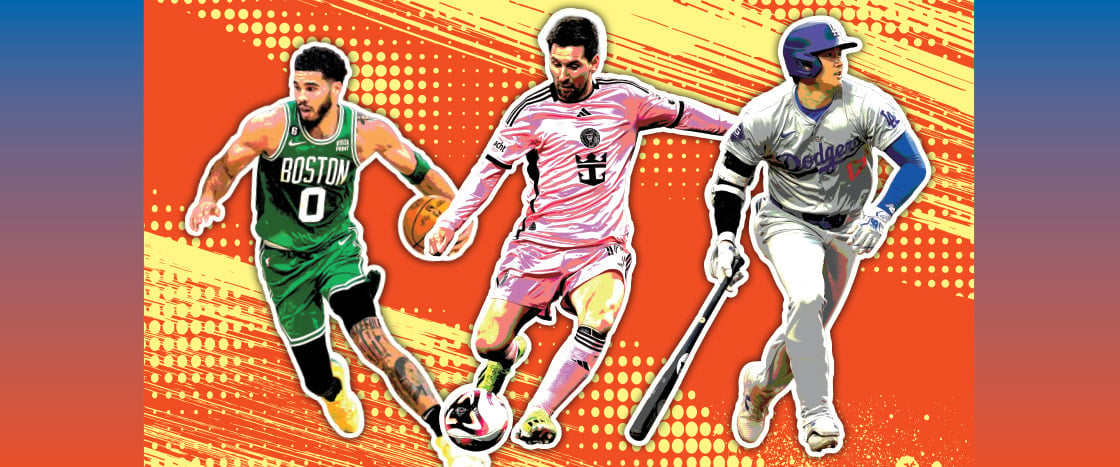Directions: Read the article, then answer the questions below.
Directions: Read the article, then answer the questions below.

Some top athletes make tens of millions of dollars. Should they?

Directions: Read the article, then answer the questions below.
Directions: Read the article, then answer the questions below.
In June 2024, basketball star Jayson Tatum’s name was everywhere. His team, the Boston Celtics, had just won the national championship, and Tatum had been a key player. But Tatum was in the news for another reason too. He had been offered a new salary: a whopping $314 million over five years!
Tatum is not alone. In 2023, Lionel Messi agreed to play as a forward for the Inter Miami soccer team for more than $20 million a year. That same year, baseball superstar Shohei Ohtani was offered the biggest salary in U.S. sports history to play for the Los Angeles Dodgers: $700 million over 10 years.
These huge salaries have restarted an old debate: Are pro athletes paid too much?
In June 2024, basketball star Jayson Tatum’s name was everywhere. His team, the Boston Celtics, had just won the national championship. Tatum had been a key player. But Tatum was in the news for another reason too. He had been offered a new salary. A whopping $314 million over five years!
Tatum is not the only one. In 2023, Lionel Messi agreed to play for the Inter Miami soccer team for more than $20 million a year. That same year, baseball superstar Shohei Ohtani was offered the biggest salary in U.S. sports history. He’s now playing for the Los Angeles Dodgers for $700 million over 10 years.
These huge salaries have restarted an old debate. Are pro athletes paid too much?
About $59,000: the amount U.S. workers make on average a year
Source: Bureau of Labor Statistics
About $59,000: the amount U.S. workers make on average a year
Source: Bureau of Labor Statistics
Big Bucks
When it comes to athletes’ salaries, it’s important to understand where the money comes from. Top sports organizations—including the NBA, the NFL, and MLB—all make billions of dollars a year. This money comes from deals that allow TV and streaming companies to show sports games. It also comes from selling tickets and merchandise like team hats and jerseys. Some people think it’s only fair that a large share of the profits goes to the athletes. After all, there would be no sports to watch without them.
Many sports fans also say that pro athletes deserve their millions because few can do what they do. Take basketball champion LeBron James. His slam dunks are incredible. He’s the NBA’s all-time top scorer. He makes tens of millions of dollars a year, and many feel he has earned that.
Of course, not all athletes earn as much as LeBron. Still, the minimum salary in the NBA is more than $1 million per year. The NFL’s is $795,000.
Those who approve of such salaries say that it takes a lot of work to become a pro athlete. To reach the top, athletes must dedicate their entire lives to their sport—to traveling, training, and competing. That can take a toll on their bodies—and even be dangerous.
“Athletes are exposed to serious injury,” says Matthew Hawzen, a professor who studies sports. “Their careers can end in a flash.”
Because their jobs are so physical, most athletes play for only three to six years. That means they have a small window of time to earn money as a player.
In June 2024, basketball star Jayson Tatum’s name was everywhere. His team, the Boston Celtics, had just won the national championship. Tatum had been a key player. But Tatum was in the news for another reason too. He had been offered a new salary. A whopping $314 million over five years!
Tatum is not the only one. In 2023, Lionel Messi agreed to play for the Inter Miami soccer team for more than $20 million a year. That same year, baseball superstar Shohei Ohtani was offered the biggest salary in U.S. sports history. He’s now playing for the Los Angeles Dodgers for $700 million over 10 years.
These huge salaries have restarted an old debate. Are pro athletes paid too much?
About $50 billion: the amount made by major U.S. sports leagues during the 2022-23 season
Sources: NFL, NBA, MLB, NHL
About $50 billion: the amount made by major U.S. sports leagues during the 2022-23 season
Sources: NFL, NBA, MLB, NHL
Too Much
But other people say that athletes are paid too much for simply playing a game. They point out that athletes who hit, pass, and shoot balls for a living are paid tens of times more than nurses, who save lives; government officials, who keep our towns running; and educators, who teach children. What does this say about our society, these people ask? Do we value entertainment more than health, safety, and education?
Besides, there are plenty of people with dangerous jobs, like construction workers and firefighters. These workers don’t get paid enormous amounts of money because their jobs are risky. Why should athletes?
What’s more, retired athletes can go on to other high-paying jobs after they quit playing sports. Many former pros become well-paid coaches or public speakers.
Then there’s the fact that usually only male athletes earn these kinds of sky-high salaries. Female players often make much less. Most players in the National Women’s Soccer League, for example, make about $65,000 a year. Many people don’t think that’s fair.
The truth is, star athletes make big bucks because of us—the sports fans. If we really think athletes shouldn’t make so much, we could stop watching them.
Would you?
In June 2024, basketball star Jayson Tatum’s name was everywhere. His team, the Boston Celtics, had just won the national championship. Tatum had been a key player. But Tatum was in the news for another reason too. He had been offered a new salary. A whopping $314 million over five years!
Tatum is not the only one. In 2023, Lionel Messi agreed to play for the Inter Miami soccer team for more than $20 million a year. That same year, baseball superstar Shohei Ohtani was offered the biggest salary in U.S. sports history. He’s now playing for the Los Angeles Dodgers for $700 million over 10 years.
These huge salaries have restarted an old debate. Are pro athletes paid too much?
Less than 2 percent: percentage of college athletes who go pro
Source: NCAA
Less than 2 percent: percentage of college athletes who go pro
Source: NCAA
What Do You Think?
Are professional athletes paid too much? Go back to the article and write down reasons to support each side of the debate. State your opinion in one sentence, which can be the topic sentence for an opinion essay on this subject.
What Do You Think?
Are professional athletes paid too much? Go back to the article and write down reasons to support each side of the debate. State your opinion in one sentence, which can be the topic sentence for an opinion essay on this subject.
Are pro athletes overpaid?
Are pro athletes overpaid?
Are pro athletes overpaid?
This article was originally published in the February 2025 issue.
This article was originally published in the February 2025 issue.
1. Preparing to Read
2. Reading the Debate
3. Discussing the Debate
4. Skill Building and Writing
Distribute or digitally assign the Write an Opinion Essay skill builder, available on two levels and in Spanish. It will guide students through collecting supporting evidence and crafting an opinion essay. The higher-level version invites students to bring in their own additional evidence and write a rebuttal of the other side. The Opinion Essay Tool Kit offers writing tips including sentence starters and transition words. (If the debate asks students to write a letter giving advice on a question, distribute the Give Your Advice letter-writing template.)
Distribute or digitally assign the Write an Opinion Essay skill builder, available on two levels and in Spanish. It will guide students through collecting supporting evidence and crafting an opinion essay. The higher-level version invites students to bring in their own additional evidence and write a rebuttal of the other side. The Opinion Essay Tool Kit offers writing tips including sentence starters and transition words. (If the debate asks students to write a letter giving advice on a question, distribute the Give Your Advice letter-writing template.)
For another debate about sports, check out “Should Everyone Get a Trophy?”
Although geared toward adults, this fascinating article from the New York Times looks at the issue of pro athletes’ salaries from a solely economic perspective. Their conclusions may surprise.
MBA Maven examines both sides of the debate in this clearly presented and engaging 8-minute video “Are Athletes Really Overpaid?” (Note: Video starts after—and is twice interrupted by—short advertisements.)